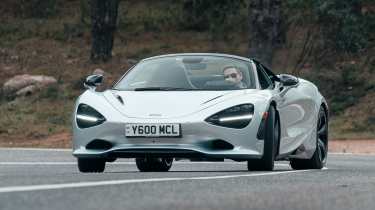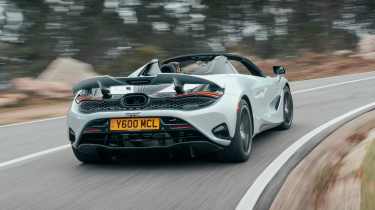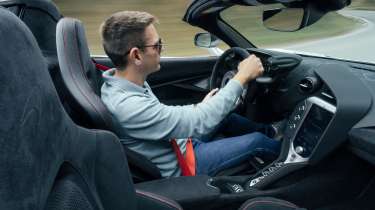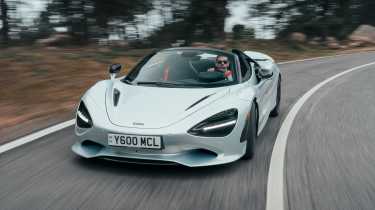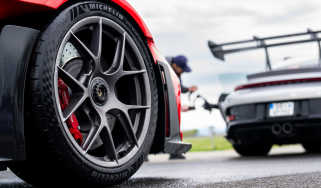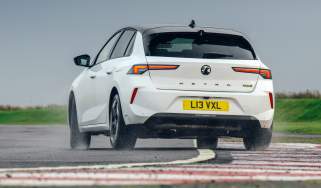McLaren 750S Spider 2024 review – an intoxicating open-top supercar
The 720S has evolved into the lighter, more powerful 750S. We test it in Spider form
The fading, cracked and wonderfully dishevelled majesty of the Circuito Estoril is a fitting backdrop for the launch of the new McLaren 750S. Nearby the roads scrabble and scrape through rock faces and reach for the coast by any means possible. The sky is sullen. It’s not one of those perfect days on a smoothly manicured surface – all deep black tarmac, brightly coloured kerbs and piercing sunlight. Instead there’s a sort of old school, no-nonsense feel to proceedings. Confidence, too. After the troubled and protracted launch of the Artura, you get the impression that the 750S – effectively a mid-life facelift of the 720S – is something of a breath of fresh air for all those connected to it. It’s a wildly quick, extremely light supercar. Simple.
So, McLaren’s latest supercar is an easy concept to understand but the lengths explored in order to achieve the stated targets are impressive and stick perfectly to this car’s core attributes. For example, as well as the power boost to 740bhp at 7500rpm and 590lb ft at 6500rpm, the 750S is also lighter by 30kg, which puts the coupé at 1389kg and the Spider we're driving here at 1438kg. Consider that we weighed the Ferrari 296 GTB to a similar standard and it came in at 1660kg and you can imagine the across-the-board benefits reaped here. Performance is truly outrageous. McLaren claims 0-62mph in 2.8-seconds, 0-124mph in 7.3-seconds and a top speed of 206mph for the Spider.
In part these numbers can be attributed to a shorter final drive, which supplements the additional power and should create even greater urgency. On the chassis side, the 750S benefits from tweaked spring rates and recalibrated settings for the hydraulically linked dampers. The new hardware is 2kg lighter. The front track is also widened by 6mm and overall the car is said to offer a more neutral balance and improvements in the already excellent body control. A faster steering rack, uprated braking system (plus an optional track braking package featuring Monobloc calipers derived from the Senna), lighter wheels and a bigger carbon fibre rear wing/airbrake all tick-up the capability of the previous model. Incremental rather than fundamental changes, but then there wasn’t much wrong with the 720S to begin with. In Spider form the 750S costs £269,160.
More reviews
Estoril is echoing to the sound of wrung-out flat-plane crank V8s as we nose out onto the road in the 750S Spider. The track activity is reserved for the coupés and they sound all-business as the turbos hit peak boost and build revs in a frenzy. It’s not exactly music despite a new and lighter (of course) central exit exhaust, but in the context of a racetrack the rabid, intense soundtrack is compelling and loaded with menace. By comparison, the Spider in its tamest settings and just escaping the confines of Estoril’s access roads is supple, subtle and feels almost laid back. Even if it rather lacks aural theatre. This split personality is a key point and what made the 720S so appealing in the first place. However, time has marched on since that car was launched in 2017. Perhaps all round brilliance just isn’t quite such an exciting drug in the world of the gorgeous and maniacally fast 296 GTB…
I’d like to string this out a bit. Really, I would. But the 750S is so immediately impressive that it seems dishonest to start with doubts and build to an epiphany. In truth, the 720S is a fantastically capable machine and the new model simply builds on those foundations and adds a bit of 765LT-inspired attitude, too. We’ll come to those sharper-edged responses later, but the great thing about the 750S is the clear sense of focus that’s palpable from the moment you duck beneath the dihedral doors. Nobody does a driving position quite like McLaren. It’s perfection. You sit so low, pedals just where you want them and the steering wheel is simple and slim. The view ahead is wonderful, too. Not only do you feel intimately connected with the car but the plunging windscreen plugs you into the road surface and the scenery it’s rushing through. Compared to the busy and slightly gaudy displays of a Ferrari 296, the McLaren feels restrained, elegant and single-minded.
So, the architecture is the same and we wouldn’t want it any other way. However, the interior fixtures of the 750S are much more of a departure from its predecessor. Gone are the rotary dials on the centre console for Handling and Powertrain, instead you select Comfort, Sport and Track for each via toggle switches mounted each side of the instrument binnacle and just a finger’s stretch from the steering wheel. The binnacle itself is mounted on the steering column and moves as you adjust rake and reach. This system, shared with the Artura, is neat and easier to use, but it does lack the drama of the old setup and the rocker action feels a bit cheap and flimsy. It also means losing the superb Folding Driver Display that was such a signature part of the 720S experience. In this instance progress feels slightly regressive. However, the big central touchscreen is a huge improvement and the addition of CarPlay will make life so much easier for owners.
Gripes about losing the old signature touches aside, the simple act of driving this car at low speed is fantastically satisfying. There’s none of the coarse vibration of the 765 LT, and the ride has a lovely sense of effortless precision. The way the 750S treads so lightly even over roads that have seen better days is exceptional and enticing. There’s a lack of inertia and a clarity to every move the car makes and a more natural, intuitive feel than its arch nemesis, the 296 GTB. Mostly this is due to the steering, which is slightly heavier than before but still percolating with rich feedback. It breeds immediate confidence. For a car with 740bhp there’s almost zero intimidation factor.
The added heft to the steering is mirrored by the more locked-down feel of the 750S in general. Just occasionally the 720S could feel a little too light on its feet – almost like the engine was taking the chassis to places it didn’t want to go – but now the car feels all of a piece. The shortened gearing ensures incredible response and there’s so much torque to call upon, but the chassis just soaks it up and the car has a consistency in the way it controls roll, pitch and dive that edges towards the 765LT but without displaying any harshness at all. The word I keep coming back to is ‘precise’ and because the car feels so honed, the steps as you ramp up from Comfort through Sport and Track modes feel more distinct, too. It’s like the more stable platform allows greater separation and stretches the appeal of the 750S further still.
Sounds civilised, doesn’t it? Light, precise, blessed with great adaptability and zinging with cerebral feedback. A kind of super-sized Elise that you think along the road. Well, yes. But it takes time to appreciate all of this as it’s initially lost in the sheer unholy speed of the thing. The shortened final drive and increased torque and top-end power combine to stunning, other-worldly effect and the way the 750S accelerates is almost overwhelming. In the Spider the explosive, relentless delivery is elevated by a layered, ever-changing soundtrack. The turbos huff, chirp and whistle, the exhaust furiously spews noise, gases and flames and, in Sport mode, the ignition cut on up- and downshifts fractures the air so violently that your adrenal glands go into overdrive. Few cars have the capacity to truly scramble senses, but the 750S Spider is absolutely on that list.
As ever, the carbon fibre tub that underpins the McLaren experience is a huge boon in Spider form. In fact, the superb work fine-tuning the suspension means the difference between coupé and Spider is smaller than ever. The rear-view mirror doesn’t buzz, the new steering system is more rigid and better located and, honestly, the dynamic penalty for the open roof version is but a sliver. For most people, I suspect it would be more than compensated for by the added intensity of the open-roof experience and the ability to just lower the rear glass on colder days and suck in all that crazy, ferocious noise.
Even when you’re fully accustomed to the performance, the 750S is a captivating car when the road gets interesting. The damping in Sport mode really is superb and although Track is a little harsh at times I do like the way it makes a positive front-end even pointier. Having said that, there isn’t the instant hyper-alert steering response of the 296 GTB that’s designed to magic away mass. The 750S doesn’t have that hybrid baggage in the first place, so can afford to be more measured yet still convey its inherent agility. That makes the 750S the more intuitive car to drive and, I suspect, easier to trust in mixed or wet conditions. It just gives you more time to think and breathe. Whether it’s quite as exciting as the stunningly sharp Ferrari is a question for another day…
Overall, the 750S Spider feels like a nicely executed update of an already deeply thrilling and useable package. The engine is more exciting and new stiffer engine mounts add connection without tripping over into annoyance, the front end has more bite and the body control keeps its cool even under duress. I like the slightly meatier steering weight and it tempers the faster rack, and the performance is simply staggering. Brake feel is improved, too. For me the only weak spots are the new engineered-in thump to gearshifts in Sport mode – which seem to go against the car’s authentic engineering-led philosophy – and the occasional sense that the rear axle could lock-up a bit more aggressively. The 750S still does without a mechanical limited-slip differential and whilst Brake Steer works really effectively on the track, it can create a slightly scrappy feel on corner exit at road speeds.
Perhaps the most compelling argument for this car remains as it was in the 720S: it does everything. The 750S looks exotic and outrageous, it feels so special thanks to the driving environment and due to its sophisticated chassis and carbon fibre construction, it copes on road and track with equal aplomb. A Ferrari 296 GTB with the Assetto Fiorano package is sharper still and an absolute monster on track, but would struggle on surfaces that the 750S Spider glides across. Plus, its hybrid system can’t perform at maximum output for more than a few laps and the added mass puts a huge amount of stress on tyres and brakes. In short, the 750S Spider is more of the same. But when the same is this good, you won’t find us complaining.

